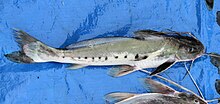Calophysus macropterus, known natively as the piracatinga/pirácatina, piranambú, pintadinho, zamurito, water buzzard,[1] or by its popular english name vulture catfish, is a species of catfish (order Siluriformes) of the monotypic genus Calophysus of the family Pimelodidae.[2] It is sometimes placed in its own family, Calophysidae.[3]
| Calophysus macropterus | |
|---|---|

| |
| Scientific classification | |
| Domain: | Eukaryota |
| Kingdom: | Animalia |
| Phylum: | Chordata |
| Class: | Actinopterygii |
| Order: | Siluriformes |
| Family: | Pimelodidae |
| Genus: | Calophysus Müller & Troschel in Müller, 1843 |
| Species: | C. macropterus
|
| Binomial name | |
| Calophysus macropterus (Lichtenstein, 1819)
| |
| Synonyms | |
Description
editThis species reaches 40 centimetres (16 in) SL,[4] though lengths of 71 centimetres (28 in) have been reported.[1] It originates from the Amazon and Orinoco basins, which encompasses waterways in Brazil, Bolivia, Colombia, Peru, and Venezuela.
The vulture catfish is so named because it is an active scavenger, seeking carcasses in its native waterways to consume in shoals; its feeding action promotes the skeletonization of its food items - they are able to consume all the muscles and viscera from an 80 kilograms (180 lb) cadaver within half an hour - though it apparently avoids feeding on cartilage elements, eyeballs, scalps, and limb extremities. Its voracious nature has lead it to becoming an important species in forensic pathology, especially concerning those victims whose corpses ended up in rivers; C. macropterus is often found in association with the cadaver even after it is extracted from the water, often being found under the victim's clothing.[1] This species is also stated to commonly attack fish caught in fishermen's nets and seines as well as those hooked on trotlines or gaffed.[4] They also seem to congregate in areas where fishermen and fishmongers dispose of fish offal.[3]
In the aquarium
editThis fish is one of the smaller pimelodids available in the trade, and may be appropriate for a large aquarium. It is an adaptable and hardy species. Tankmates should be chosen with great care as this fish has the ability to bite and tear off pieces of flesh,[3] although many who have actually kept the fish report no apparent signs of aggression.[5]
References
edit- ^ a b c Valente-Aguiar, Murilo Sérgio; Falcão, Ana Cecília; Magalhães, Teresa; Dinis-Oliveira, Ricardo Jorge (2020). "Cadaveric ichthyofauna of the Madeira River in the Amazon basin: the myth of man-eating piranhas". Forensic Science, Medicine, Pathology. 16: 345–351. doi:10.1007/s12024-020-00221-8. Retrieved 1 November 2024.
- ^ "Calophysus macropterus". Integrated Taxonomic Information System. Retrieved May 23, 2007.
- ^ a b c "PlanetCatfish::Catfish of the Month::May 2006". 2006-05-10. Retrieved 2007-06-08.
- ^ a b Froese, Rainer; Pauly, Daniel (eds.). "Calophysus macropterus". FishBase. February 2012 version.
- ^ "Calophysus macropterus (Vulture Catfish) Questions". 2011-06-08. Retrieved 2011-12-12.
- Ros, Wolfgang and Schmidt, Jakob (2008): "Calophysus macropterus: Ein 'Hai' im Süßwasseraquarium", D. Aqu. u. Terr. Z. (Datz) 61 (4): 16-18.